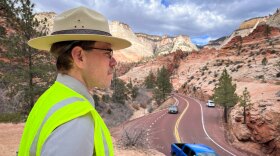-
Utah is stepping in to keep parks open while Congress hashes out the funding gap. Local businesses say that support has been a lifeline during a tricky year for park visitation.
-
La cantidad de visitantes ha disminuido en todos los parques de Utah, impulsada por una baja en el turismo internacional. La incertidumbre económica y la retórica política podrían estar alejándolos, con grandes implicaciones para las economías locales que dependen de ellos.
-
Visitation is down at all of Utah’s parks, driven by a decline in international visitors. Economic uncertainty and political rhetoric may be keeping them away, with big implications for local economies that depend on them.
-
Millions of people visit Utah’s national parks for their awe-inspiring views, but air pollution often gets in the way. Federal moves to reverse emission-cutting policies could put the parks’ air even more at risk.
-
Zion National Park’s staff numbers haven’t kept up with rising visitation, and the Trump administration’s federal hiring freeze hasn’t helped. Park officials say visitors should help prevent search and rescue operations by planning ahead.
-
Landslides triggered by 2023’s wet winter damaged the original bridge. The relocated bridge will better accommodate shifts in the Virgin River.
-
Utah’s national park lands see over 15 million visitors each year, and that number continues to grow. Zion National Park is the country’s third-most visited park.
-
National Park Service officials say the 40-year-old man was rappelling through Heaps Canyon with three others on Saturday evening when he fell to his death. His identity has not been released.
-
Capitol Reef National Park’s fruit orchards — planted by Mormon pioneers — are a big attraction. But as old trees die and heirloom varieties become harder to find, the park is racing to preserve a juicy piece of Utah history.
-
Tourists continue to flock to parks in Utah and other southwestern states during the hottest months of the year, even as officials caution that hiking in extreme heat poses serious health risks.
-
The National Park Service is rolling out a plan to reroute oversized vehicles off the Zion-Mt. Carmel Highway, citing safety and the road’s infrastructure.
-
Window collisions are a big threat during spring bird migration. New window treatments going up at Zion National Park are part of a movement to reduce glass strikes.
Play Live Radio
Next Up:
0:00
0:00
Available On Air Stations











